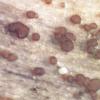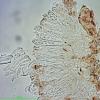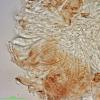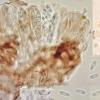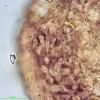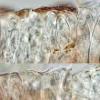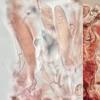
27-10-2025 00:34
 Francois Guay
Francois Guay
I found this strange species in Québec,Canada, gr

27-10-2025 15:29
 Michel Hairaud
Michel Hairaud
Bonjour à tous, Avec Elisabeth Stöckli nous avo

26-10-2025 13:39
Joaquin MartinHi,I found this fungus in a mixed forest of spruce

26-10-2025 21:23
Juuso ÄikäsHello, a couple weeks ago I found some pale, whit

23-10-2025 20:59
Patrice TANCHAUDBonsoir, est-ce que quelqu'un posséderait un com

24-10-2025 14:50
 Riet van Oosten
Riet van Oosten
Hello, Found by Laurens van der Linde, Oct. 2025
The disks are sessile, 80-200 µm wide, with a darker slightly raised margin. The exciple is covered with a crust covering everything and preventing a view of what is behind. A similar crust is in part also covering the hymenium (pseudoepithecium?). Asci eight-spored, 32-55 × 5.9-7.3 µm, the bases are so agglutinated that I dont't know about croziers, negative in Lugol with and without pretreatment. The spores are 7.0-8.0 × 2.6-2.9 µm, with a few small guttules at each end. The parafyses are slighly clavate, 3.0-4.2 µm at apex and unfortunately so easily dying that I can't say anything about their contents.
I can't find a Micropeziza with such small spores - or is it something else?

But I think I found some living parafyses. They have a not very refractive guttule at the apex. They are very sensitive to pressure - as soon as I touch the cover slip they are mostly gone.
The crust of my fungus is very similar to the the one on photo "Durella, II.2014-2" in the Skyttea folder.

Thank you, I suppose this is as far as it is possible to get with morphology alone.


